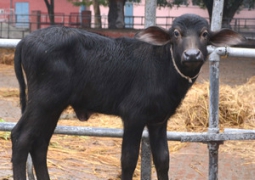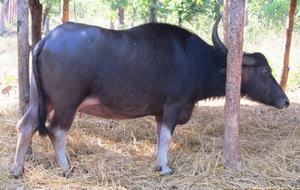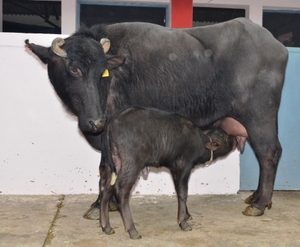ICAR-NDRI Clones Endangered Wild Buffalo of Chhattisgarh
Karnal, Haryana, January 04, 2014: In a first of its kind, National Dairy Research Institute (NDRI), Karnal, successfully cloned Chhattisgarh’s state animal, the wild buffalo. Dr AK Srivastava, Director and Vice Chancellor, NDRI, informed that the clone of the only wild-buffalo in Udanti Wildlife Sanctuary, Chhattisgarh, in semi-captivity has been produced through the ‘Hand-guided Cloning Technique’ at ICAR-NDRI. The female calf was named “Deepasha” and was born on December 12, 2014, by normal parturition, and the calf’s weight at the time of birth was 32 kg.
With only one female wild buffalo left in Udanti Wildlife Sanctuary in Chhattisgarh, this step is a pioneering effort in the conservation of the species. The last remaining female wild buffalo, named Asha, has delivered five male calves since 2006. This became a major cause of concern for the Chhattisgarh Forest Department as she was the only hope of giving birth to a female calf that could have ensured the sustenance of this particular species in Chhattisgarh. Wildlife Trust of India (WTI) approached NDRI for assistance by initiating research to clone the wild buffalo. “We gladly accepted the challenge of exploring the totally unknown path of research with partial funding from the state and support in sampling the tissue from the animals,” said Dr SK Singla, Senior Scientist, NDRI.
WTI has been at the forefront of the in-situ breeding programme of wild buffaloes in the state in an effort to stop them from going extinct. The programme has been functional in Udanti for past many years. In 2006-07, a joint survey of forest department and WTI established that only seven wild buffaloes remained in Udanti in mid-2010 and that only one of them was female. The population in 2000 was estimated to be around 30 and these new figures indicated that the species’ local extinction was imminent.
Dr RP Mishra, Regional Head, Central India, WTI, who is handling Wild Buffalo Recovery Project since 2006, said, “Besides, Asha giving birth to male calves in last few years was a major cause of concern. In April 2013, the project for cloning was conceived with NDRI. For the time being, the cloned calf has to be kept under complete care and precaution for at least two years. As cloning is a sensitive process, the calf would need lot of care at Karnal institute. Once other buffaloes give birth to more calves, they will be sent to Chhattisgarh.”
WTI in 2005 signed a MoU with the Chhattisgarh Forest Department on Wild Buffalo Recovery Project wherein an evaluation on the number of wild buffaloes in four wildlife sanctuaries namely Udanti, Pamed, Sitanadi and Bhairamgarh, and Indravati National Park in Chhattisgarh would be conducted. The survey revealed that no buffaloes remained in Sitanadi and Bhairamgarh WLS. Indravati NP had a relatively large population of about 30 individuals and Pamed WLS had 5-8 buffaloes, but no conservation initiatives could be undertaken in these Protected Areas owing to Maoist presence.
“Following these stark revelations, WTI helped the Forest Department prepare a five-year Action Plan for the recovery of the wild buffalo population in Udanti. The Action Plan which was subsequently approved by the Governing Council of the project comprised three basic objectives – ensuring zero unnatural deaths of the remaining individuals, habitat improvement, and population augmentation by re-stocking (especially females) from closely-related populations or conservation breeding,” added Dr. Mishra.
The team of the scientists involved in the cloning include: Dr SK Singla, Dr MS Chauhan, Dr RS Manik, Dr P Palta, Dr SS Lathwal, Anuj Raja and Amol Sahare. Scientists are of the opinion that besides multiplication of superior germplasm through cloning, conservation of endangered species through cloning has great potential. As our domestic buffalo has evolved from wild-buffalo, we may need to extract few traits of biological and/or economic importance from these wild animals in future.
Dr S Ayyappan, Secretary, DARE, and Director General, Indian Council of Agricultural Research (ICAR), New Delhi, congratulated the team and renewed his confidence in the team. He said that this novel achievement of cloning calf from an endangered species has opened a new window of possibilities in cloning technology.
“Birth of Deepasha has given us hope that the wild buffaloes could once again roam the forests of Udanti. This is a testimony of how serious the state forest department has been in the conservation efforts of the animal that is also the pride of the state. It is a moment of great joy and we congratulate everyone associated with this project,” said Ram Prakash, PCCF & HOFF, Chhattisgarh.
Locally known as ‘ban bhainsa’, the Wild buffalo is in the Red List of International Union for Conservation of Nature (IUCN) and is also a Schedule I animal under the Wildlife (Protection) Act, 1972.












